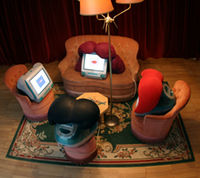http://en.wikipedia.org/wiki/New_media_art
New media art is a genre that encompasses artworks created with new media technologies, including digital art, computer graphics, computer animation, virtual art, Internet art, interactive art, video games, computer robotics, and art as biotechnology. The term differentiates itself by its resulting cultural objects and social events, which can be seen in opposition to those deriving from old visual arts (i.e. traditional painting, sculpture, etc.). This concern with medium is a key feature of much contemporary art and indeed many art schools and major Universities now offer majors in "New Genres" or "New Media"[1] and a growing number of graduate programs have emerged internationally.[2] New Media Art often involves interaction between artist and observer or between observers and the artwork, which responds to them. Yet, as several theorists and curators have noted, such forms of interaction, social exchange, participation, and transformation do not distinguish new media art but rather serve as a common ground that has parallels in other strands of contemporary art practice.[3] Such insights emphasize the forms of cultural practice that arise concurrently with emerging technological platforms, and question the focus on technological media, per se.
New Media concerns are often derived from the telecommunications, mass media and digital modes of delivery the artworks involve, with practices ranging from conceptual to virtual art, performance to installation.
Themes

G.H. Hovagimyan "A Soapopera for iMacs"

Maurizio Bolognini's programmed machines (Computer sigillati series, 1992): hundreds of computers have been producing endless flows of random images.[7]
Non-linearity can be seen as an important topic to new media art by artists like Bill Viola who explores the term as an approach to looking at varying forms of digital projects. This is a key concept since people acquired the notion that they were conditioned to view everything in a linear and clear-cut fashion. Now, art is stepping out of that form and allowing for people to build their own experiences with the piece. People always ask, "What is the difference between non-linearity and randomness?" Non-linearity describes a project that has freedom with certain parameters, whereas randomness has freedom and no boundaries whatsoever. Non-linear art usually requires audience participation to reveal its non-linearity while random art, more-or-less, acts on its own. In doing so, viewers can understand another theme in the many forms of new media art. The participatory aspect of new media art, which for some artists has become integral, emerged from Allan Kaprow's Happenings.
The inter-connectivity and interactivity of the internet, as well as the fight between corporate interests, governmental interests, and public interests that gave birth to the web today, fascinate and inspire a lot of current new media art.
Many new media art projects also work with themes like politics and social consciousness, allowing for social activism through the interactive nature of the media.
One of the key themes in new media art is to create visual views of databases. Pioneers in this area include Lisa Strausfeld and Martin Wattenberg.[11] Database aesthetics holds at least two attractions to new media artists: formally, as a new variation on non-linear narratives; and politically as a means to subvert what is fast becoming a form of control and authority.
No comments:
Post a Comment